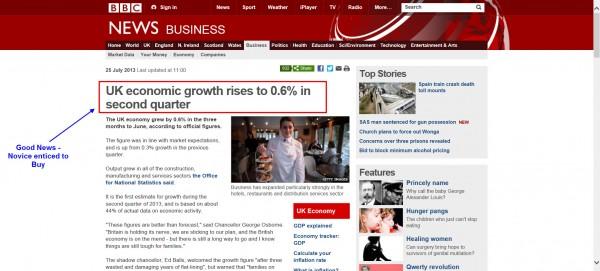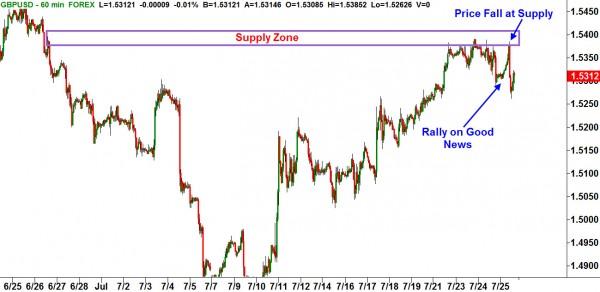![]()
If there is one question that I get asked more than any other it would be the following, “When did you really start to make trading work?” Of course, I could put a number of months or years as my answer or even I could say that education is the reason why I managed to start making it work for me. But the truth is, it really turned around when I started to follow my plan. When you tell people this, it’s usually not the answer that they want to hear. Typically, a new student expects you to say something about how it was all down to a special technical indicator or chart pattern. Others will expect you to say it’s because of the amount of screen-time that I have managed to achieve over the years, because they often think that the longer and harder you stare at the screen, the better you become at trading. However like I said at the start, it’s all about having the right plan and when you have that plan, there is one special ingredient left: you. And that’s the tricky part that most people don’t understand. Let me explain.
Some people believe that if you formulate a sensible, disciplined and objective trading plan, you could give it to anybody and they could make it work. After all, the trading plan is nothing more than a set of instructions which are telling you exactly what to do and when to do it. There is a little bit more to this though. You see a well crafted trade plan is a personal document which offers rules to the person who is using it and is based on that trader’s personality and characteristic traits. It is this dynamic which makes the trade plan so unique and is why one plan may suit a trader but not another. The conundrum that most people face however, especially novice traders who have been struggling for a long time in the market, is that firstly they don’t have the right education to know what rules to put into their strategy and formulate their trade plan and secondly is that they struggle to be objective.
When I am teaching a class it is easy for me to lay out the rules and show my students exactly how the Online Trading Academy Core Strategy works, simply because I get to spend at least 5 to 7 days with the class, in which I will lay out clearly in a step by step process exactly how to identify institutional levels of demand and supply in the market. When we find the demand zone we buy at that demand zone and when we find the supply zone we sell short at that supply zone, defining our entry, stop loss and our profit target all in advance before the market turns. The objective analysis and rules of our trade plan guide us and tell us what to do, thus removing all emotion from the process of finding the trade and taking it.
Many new traders and students at our Academy find this simple step-by-step process easy to understand and even easier to put into action. This is because they’ve been taught how to do this in the right way from the very start. However, some of the more experienced traders who’ve been struggling up until the point of joining the academy, find this a little more taxing because they have already made many mistakes before joining us, gotten into a lot of bad habits and they find it hard to redefine their strategy and rewrite the plan. It’s completely understandable when you think about it, because if you have been doing something wrong for a long time it creates a bad habit and that habit can be tough to break. In fact many times when I have a student who does have a little bit of experience in the market, they often struggle with learning new concepts and forgetting about their old ways of doing business. In an effort to help them along in their journey, I always tell my students to start their trading education in the right way, by coming to class with an empty cup.
I am sure that you’re not surprised to learn that most people look at me with a blank expression when I tell them this! Yet the concept is rather simple. If you come to learning anything new for the first time with a head full of ideas and you try to add to this, you typically get lost quickly, finding yourself unable to adapt to learn new principles. It’s often hard to let go of the past and the methods you have been using up until this point, whether they have been working or not. Just like a cup of water, if the cup is already full and you add more water to it your cup will overflow. The human brain is really no different. The student who comes to class with a head full of preconceived ideas has little room to learn and understand brand-new concepts. Come to class with an open mind and you’ll be surprised how much you start to take in. However this concept of the empty cup needs to also expand beyond the classroom environment, and into the world of live trading. When the student or Trader has learned the concepts they need to be successful and has a plan to follow in the markets, they need to empty their head from anything else and follow the rules by the book.
While this may seem easy to do once you’ve had the right education, it still takes discipline and practice to follow the charts and your plan, rather than have a full cup and try to absorb too much other information which is around you. Take this piece of news for example that I found today:
I saw this piece of news which was released on the morning of writing this article. It was a positive news piece, showing that the growth forecast for GDP in Great Britain, had risen by 0.6%. If you were paying attention to this news piece, it would be no surprise to find yourself wanting to buy the GBPUSD Currency on the back of the good news. The trader attempting to absorb all the information that they can in order to pick the direction in the marketplace, would have easily pressed the buy button, having read this news. Let’s see how that would have worked out:
As we can see, frustration would’ve hit pretty quickly as the GBPUSD currency pair rallied up for a short time and then collapsed almost 100 pips from the predetermined area of supply. While the news driven Trader, absorbing as much information as they could, would be scratching their head in wonder as to why the market has fallen, the disciplined Trader with an objective set of rules, understood exactly why they should ignore the news and short at the institutional level of supply.
Once you have the plan,you follow the plan, ignoring any other extra news or information which could quite easily fill up your “cup” and overspill into messing up your trade.
When people ask me what it takes to be successful in the market I always tell them once you have the plan, you have to follow the plan and that means switching off from any other outside information which could deter you from following the rules you have set yourself. My cup is only as full as it needs to be, allowing my brain to take the signals that show me when to be an objective buyer or seller in the ongoing currency market place. I hope you find this helpful.
Have a great trading week.
Note: All information on this page is subject to change. The use of this website constitutes acceptance of our user agreement. Please read our privacy policy and legal disclaimer. Opinions expressed at FXstreet.com are those of the individual authors and do not necessarily represent the opinion of FXstreet.com or its management. Risk Disclosure: Trading foreign exchange on margin carries a high level of risk, and may not be suitable for all investors. The high degree of leverage can work against you as well as for you. Before deciding to invest in foreign exchange you should carefully consider your investment objectives, level of experience, and risk appetite. The possibility exists that you could sustain a loss of some or all of your initial investment and therefore you should not invest money that you cannot afford to lose. You should be aware of all the risks associated with foreign exchange trading, and seek advice from an independent financial advisor if you have any doubts.
Editors’ Picks
EUR/USD holds above 1.0700 ahead of key US data

EUR/USD trades in a tight range above 1.0700 in the early European session on Friday. The US Dollar struggles to gather strength ahead of key PCE Price Index data, the Fed's preferred gauge of inflation, and helps the pair hold its ground.
USD/JPY jumps above 156.00 on BoJ's steady policy

USD/JPY has come under intense buying pressure, surging past 156.00 after the Bank of Japan kept the key rate unchanged but tweaked its policy statement. The BoJ maintained its fiscal year 2024 and 2025 core inflation forecasts, disappointing the Japanese Yen buyers.
Gold price flatlines as traders look to US PCE Price Index for some meaningful impetus

Gold price lacks any firm intraday direction and is influenced by a combination of diverging forces. The weaker US GDP print and a rise in US inflation benefit the metal amid subdued USD demand. Hawkish Fed expectations cap the upside as traders await the release of the US PCE Price Index.
Sei Price Prediction: SEI is in the zone of interest after a 10% leap

Sei price has been in recovery mode for almost ten days now, following a fall of almost 65% beginning in mid-March. While the SEI bulls continue to show strength, the uptrend could prove premature as massive bearish sentiment hovers above the altcoin’s price.
US core PCE inflation set to signal firm price pressures as markets delay Federal Reserve rate cut bets

The core PCE Price Index, which excludes volatile food and energy prices, is seen as the more influential measure of inflation in terms of Fed positioning. The index is forecast to rise 0.3% on a monthly basis in March, matching February’s increase.
RECOMMENDED LESSONS
Making money in forex is easy if you know how the bankers trade!
Discover how to make money in forex is easy if you know how the bankers trade!
5 Forex News Events You Need To Know
In the fast moving world of currency markets, it is extremely important for new traders to know the list of important forex news...
Top 10 Chart Patterns Every Trader Should Know
Chart patterns are one of the most effective trading tools for a trader. They are pure price-action, and form on the basis of underlying buying and...
7 Ways to Avoid Forex Scams
The forex industry is recently seeing more and more scams. Here are 7 ways to avoid losing your money in such scams: Forex scams are becoming frequent. Michael Greenberg reports on luxurious expenses, including a submarine bought from the money taken from forex traders. Here’s another report of a forex fraud. So, how can we avoid falling in such forex scams?
What Are the 10 Fatal Mistakes Traders Make
Trading is exciting. Trading is hard. Trading is extremely hard. Some say that it takes more than 10,000 hours to master. Others believe that trading is the way to quick riches. They might be both wrong. What is important to know that no matter how experienced you are, mistakes will be part of the trading process.


